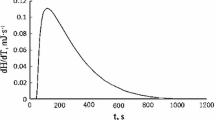Summary
A technique is described to obtain renal interstitial fluid (RIF) from rabbits after implantation of diffusion chambers with permeable membranes of 0.45 µ porosity in both kidneys. Pharmacokinetic studies were conducted two to three weeks after implantation. No difference in gentamicin concentrations, as measured microbiologically, was seen between RIF withdrawn from the left and right kidney chambers at the same points in time. Simultaneous drug concentrations were determined in RIF and serum of rabbits after oral administration of ampicillin or nalidixic acid and after intramuscular injection of gentamicin. Ampicillin concentrations in RIF peaked at two hours with about one fourth of the peak concentration measured in serum at one hour. These curves crossed at 3.45 hours. In RIF, the maximum concentration of gentamicin found at two hours was again approximately one fourth of the serum peak level determined at half an hour. The gentamicin curves crossed at 3.15 hours. No levels of nalidixic acid could be detected microbiologically in serum and RIF. In collected urine, however, concentrations of this drug could be measured for several sampling periods. Our results show that this diffusion chamber technique can be useful in the pharmacokinetic examination of drugs, also with respect to their distribution in the kidneys.
Zusammenfassung
Es wird eine Methode zur Gewinnung von renaler Interstitialflüssigkeit (RIF) durch Implantation von Diffusionskammern mit permeablen Membranen (Porengröße 0.45 µ) in beide Nieren von Kaninchen beschrieben. Pharmakokinetische Untersuchungen begannen zwei bis drei Wochen nach der Implantation. Unabhängig ob die Proben aus der linken oder der rechten Niere gewonnen wurden, waren die mikrobiologisch bestimmten Wirkstoffspiegelkonzentrationen, wie am Beispiel Gentamicin gezeigt werden konnte, praktisch gleich. Simultane Wirkstoffspiegel in RIF und Serum wurden nach oraler Verabreichung von Ampicillin und Nalidixinsäure und nach intramuskulärer Injektion von Gentamicin bestimmt. Die höchste Ampicillin-Konzentration in RIF wurde zwei Stunden nach Applikation gemessen und betrug ein Viertel der eine Stunde nach Verabreichung gefundenen Maximalwerte des Ampicillin im Serum. Die Serum- und die RIF-Kurven kreuzten sich 3,45 Stunden nach Substanzverabreichung. Für Gentamicin wurden die höchsten Spiegelwerte in RIF nach zwei Stunden bestimmt. Sie betrugen ebenfalls ca. ein Viertel der im Serum nach einer halben Stunde gefundenen Maximalwerte. Der Schnittpunkt beider Kurven lag bei 3,15 Stunden nach Applikation. Bei mit Nalidixinsäure behandelten Kaninchen waren mikrobiologisch keine antibakteriellen Aktivitäten in Serum und RIF nachweisbar, jedoch z. T. hohe Spiegel in Sammelurinproben. Die erhobenen Befunde bestätigen die Brauchbarkeit dieser Diffusionskammermethode für pharmakokinetische Untersuchungen antibakterieller Wirkstoffe auch hinsichtlich ihrer Verteilung in der Niere.
Similar content being viewed by others
Literature
Laber, G., Schütze, E., Leskova, R., Kolb, R., Georgopoulos, A.: A diffusion chamber technique for measuring concentrations of antibiotics in extravasal fluid. Infection (in press).
Eickenberg, H. U., Waterman, N. G., Scharfenberger, L. Renal interstitial fluid, urine and serum antibiotic concentration. Surg. Forum 26 (1975) 589–591.
Eickenberg, H. U., Waterman, N. G., Scharfenberger, L. Concentration of antibiotics in renal interstitial fluid: An experimental model. Urol. Res. 3 (1975) 165–167.
Eickenberg, H. U., Scharfenberger, L., Waterman, N. G. Concentration of antibiotics in renal interstitial fluid, soft tissue interstitial fluid, urine and serum. Infection 4 Suppl. 2 (1976) 97–102.
Eickenberg, H. U., Scharfenberger, L., Waterman, N. G. A new model for measuring concentration of antibiotics in prostatic interstitial fluid. Infection 4 Suppl. 2 (1976) 108–110.
Waterman, N. G., Raff, M. J., Scharfenberger, L., Barnwell, P. A. Antibiotic concentrations in hepatic interstitial and wound fluid. Surg. Gynecol. Obstet. 142 (1976) 235–238.
Georgopoulos, A. A simple micro agar diffusion method for the determination of antibiotic concentrations in blood and other body fluids. Zbl. Bakt. Hyg. I. Abt. Orig. A 242 (1978) 387–393.
Snedecor, G. W., Cochran, W. G. Statistical methods. Iowa State University Press, Ames 1971.
Schmook, F. P., Nefzger, M., Laber, G., Georgopoulos, A., Czok, R., Schütze, E.: Composition of fluid from diffusion chambers implanted in the soft tissue and the kidneys of rabbits. Infection (in press).
Chisholm, G. D., Waterworth, P. M., Calnan, J. S., Garrod, L. P. Concentration of antibacterial agents in interstitial tissue fluid. Br. Med. J. 1 (1973) 569–573.
Author information
Authors and Affiliations
Rights and permissions
About this article
Cite this article
Georgopoulos, A., Schütze, E. & Laber, G. Measurements of antimicrobial drug concentrations in renal interstitial fluid using the diffusion chamber technique. Infection 8, 115–118 (1980). https://doi.org/10.1007/BF01641474
Received:
Issue Date:
DOI: https://doi.org/10.1007/BF01641474



